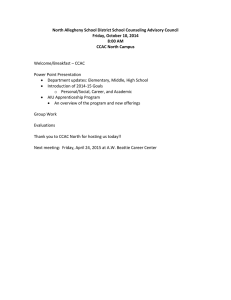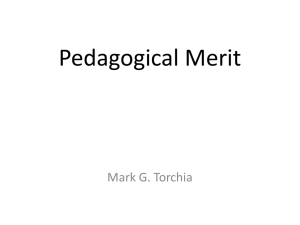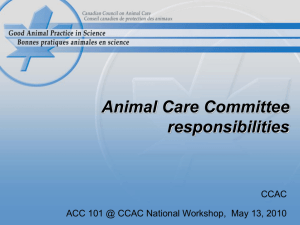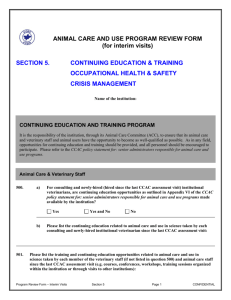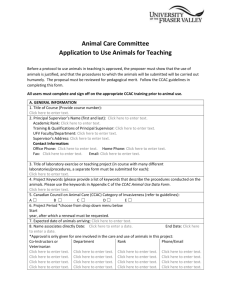CCAC guidelines on: training of personnel working with animals in
advertisement
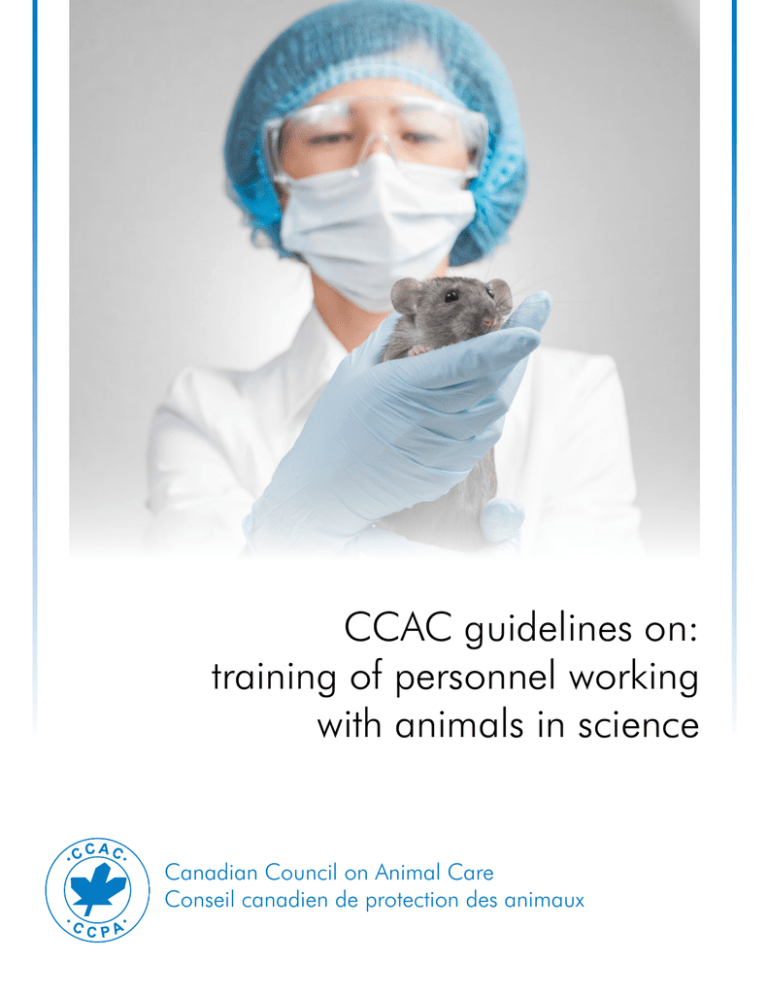
CCAC guidelines on: training of personnel working with animals in science Canadian Council on Animal Care Conseil canadien de protection des animaux © Canadian Council on Animal Care, 2015 ISBN: 978-0-919087-59-0 Canadian Council on Animal Care 190 O’Connor St., Suite 800 Ottawa ON K2P 2R3 http://www.ccac.ca ACKNOWLEDGEMENTS The CCAC guidelines on: training of personnel working with animals in science is a revision of the CCAC guidelines on: institutional animal user training (1999). It was developed by the staff of the Canadian Council on Animal Care Secretariat. The document incorporates comments received from 38 reviewers located at 27 different academic, government and private sector organizations across Canada. We are grateful to the many individuals who provided comments and we especially acknowledge the contributions of the CCAC Standards Committee members, who provided important feedback and assistance in developing the guidelines. Dr. Mark Torchia Chair of the CCAC Board of Directors Dr. Louise Desjardins CCAC Executive Director Table of Contents TABLE OF CONTENTS 1. PREFACE...................................................................................................................1 SUMMARY OF THE GUIDELINES LISTED IN THIS DOCUMENT..................................2 2. GENERAL CONSIDERATIONS.................................................................................4 3. PRINCIPLES AND OBJECTIVES OF TRAINING......................................................5 4. RESPONSIBILITIES OF INSTITUTIONS...................................................................6 4.1 Resource Materials for Training Programs............................................................................................6 4.2 Access to Training ......................................................................................................................................7 4.3 Evaluating and Documenting Competency...........................................................................................7 5. ADDRESSING TRAINING NEEDS............................................................................8 5.1 Animal Users...............................................................................................................................................8 5.2 Veterinarians and Animal Care Staff......................................................................................................8 5.3 Husbandry Staff..........................................................................................................................................9 5.4 Undergraduate Students Who Do Not Take Part in Animal-Based Research Projects.................9 5.5 Others Involved with Animals................................................................................................................9 6. REFERENCES.........................................................................................................10 APPENDIX 1 RECOMMENDED SYLLABUS FOR AN INSTITUTIONAL ANIMAL USER TRAINING PROGRAM.................................................................................. 11 CCAC guidelines on: training of personnel working with animals in science i Table of Contents CCAC guidelines on: training of personnel working with animals in science ii Section 1 – Preface training of personnel working with animals in science 1 PREFACE The Canadian Council on Animal Care (CCAC) is the national peer review agency responsible for setting and maintaining standards for the ethical use and care of animals used in science. The CCAC publishes guidelines on the general care and use of animals in science, as well as issues of current and emerging ethical concern. The CCAC guidelines on: training of personnel working with animals in science is a revision of the CCAC guidelines on: institutional animal user training, published in 1999. The CCAC guidelines on: training of personnel working with animals in science forms the foundation for the training, supervision and attainment of competence for all personnel involved in the care and use of animals in science. It focuses on general principles to permit institutions to determine the relevant requirements for the various categories of personnel and/or design training programs that meet the requirements of the CCAC and are tailored to individual institutional needs. “Personnel working with animals in science” includes animal users, as well as those involved in the care and husbandry of animals used in science. For animal users, the CCAC guidelines on: training of personnel working with animals in science is the basis for the CCAC National Institutional Animal User Training (NIAUT) Program, which also includes the Recommended Syllabus for an Institutional Animal User Training Program and resource materials, such as the CCAC animal user training materials, to support the development and implementation of institutional training programs. The CCAC recognizes that many institutions have excellent training programs in place. The guidelines should in no way detract from these programs and, in fact, the guidelines were developed based on successful training programs and the experiences of these institutions. CCAC guidelines on: training of personnel working with animals in science 1 Summary of Guidelines SUMMARY OF THE GUIDELINES LISTED IN THIS DOCUMENT 2. GENERAL CONSIDERATIONS Guideline 1: All personnel working with animals in science must be knowledgeable about the principles of humane experimental science and ethical issues associated with the use of those animals, including the Three Rs tenet (replacement, reduction and refinement). P. 4 3. PRINCIPLES AND OBJECTIVES OF TRAINING Guideline 2: Institutions must strive to sustain an institutional culture of respect for animal life. P. 5 4. RESPONSIBILITIES OF INSTITUTIONS Guideline 3: Institutions should ensure appropriate resource materials are available to support the delivery of comprehensive, up-to-date training programs. Section 4.1 Resource Materials for Training Programs, p. 6 Guideline 4: Training programs must be designed to be consistent with the Three Rs (replacement, reduction and refinement). Section 4.1 Resource Materials for Training Programs, p. 6 Guideline 5: Access to training must be offered on a regular basis to ensure that all personnel working with animals possess the necessary knowledge, skills and competency to perform their required tasks prior to commencement of any work involving animals. Section 4.2 Access to Training, p. 7 CCAC guidelines on: training of personnel working with animals in science 2 Summary of Guidelines Guideline 6: Institutions are responsible for providing evidence that all personnel working with animals have the appropriate knowledge, skills and competency to perform their required tasks. Section 4.3 Evaluating and Documenting Competency, p. 7 5. ADDRESSING TRAINING NEEDS Guideline 7: All animal users must have the theoretical knowledge and practical skills necessary to be competent to perform their required tasks. When practical skills need to be acquired, the training should be timed in relation to when performance of the skills is required. Section 5.1 Animal Users, p. 8 CCAC guidelines on: training of personnel working with animals in science 3 Section 2 – General Considerations 2 GENERAL CONSIDERATIONS Guideline 1: All personnel working with animals in science must be knowledgeable about the principles of humane experimental science and ethical issues associated with the use of those animals, including the Three Rs tenet (replacement, reduction and refinement). All personnel involved in the care and use of animals for research, teaching and testing must possess: • an understanding of the ethical issues of using animals for scientific purposes in Canada and an understanding of the Three Rs tenet (replacement, reduction and refinement); • knowledge of the principles of experimental animal science relevant to their area of work (laboratory, field, or agriculture); and • knowledge, skills and competency required for any procedure they need to carry out, including handling of the animals. The Three Rs tenet is embedded in the conduct of animal-based science in Canada and encourages individuals to: • Replace − avoid or replace the use of animals wherever possible; • Reduce − employ strategies that will result in fewer animals being used and which are consistent with sound experimental design; and • Refine − modify husbandry or experimental procedures to minimize pain and distress. For more information, see http://www.ccac.ca/en_/standards/threer. CCAC guidelines on: training of personnel working with animals in science 4 Section 3 – Principles and Objectives of Training 3 PRINCIPLES AND OBJECTIVES OF TRAINING Guideline 2: Institutions must strive to sustain an institutional culture of respect for animal life. The underlying purpose of any training of personnel is to foster a philosophy of compassion and respect for the animals used in science, while providing the necessary knowledge (including an understanding of the principles of the Three Rs) and skills to ensure competency in carrying out required tasks and procedures. Competency refers to the ability to effectively perform a particular task in relation to the care, maintenance or use of the animals, while ensuring their welfare is protected as far as possible within the constraints of any approved studies that the animals are involved in. Focusing on competency rather than training acknowledges that there may be a variety of ways of acquiring the necessary knowledge and skills, and places emphasis on learning outcomes. Institutions must establish a means of assessing the competency of individuals prior to permitting them to carry out any procedures related to the care and/or use of animals. Until personnel have had their competency assessed and been found to be competent to perform the relevant tasks or procedures, any work with animals should be carefully supervised. This supervision should aim to reinforce understanding and ensure tasks and procedures are conducted according to the appropriate standard. The duration of supervision required for competence to be attained will vary with the frequency of the task, the technical complexity of the task, and the ability of the individual. Training programs should contribute to the development of knowledge, skills and competency relevant to tasks that will be undertaken. Such programs should ensure the availability of both theoretical and practical training, and recognize that a flexible approach is required to address the training requirements of individuals with various needs and levels of experience. Competent trainers and supervisors are essential to maintaining high standards for the care and use of animals in science, and institutions should ensure such designations are assigned appropriately. CCAC guidelines on: training of personnel working with animals in science 5 Section 4 – Responsibilities of Institutions 4 RESPONSIBILITIES OF INSTITUTIONS Institutions should establish and implement policies that provide for a system of animal care to meet the needs of the institution in maintaining humane and ethical standards of experimental science. This includes providing access to relevant training resources for personnel working with animals to ensure their competence. Responsibility for ensuring appropriate supervision and training of all involved with animals should be shared among the institution, the animal care committee (ACC), veterinarians, principal investigators and supervisors. Animals may experience a greater degree of pain and/or distress when subjected to experimental procedures by inexperienced individuals who do not possess the appropriate knowledge, skills and competency. Therefore, the institution should ensure that appropriate training resources are available to all personnel using animals, and must ensure that those lacking competence with the species or procedures have adequate supervision. 4.1 Resource Materials for Training Programs Guideline 3: Institutions should ensure appropriate resource materials are available to support the delivery of comprehensive, up-to-date training programs. There is a wealth of training resources available, and institutions may choose among the following options: • develop their own training materials, based on the specific needs of those working with animals and the tasks and procedures carried out; or • use training materials from other institutions or organizations (e.g., Canadian Association for Laboratory Animal Science) and/or CCAC training materials, either partially or in full. Additionally, institutions may choose to recognize training from another CCAC-certified institution for personnel coming from that institution. Guideline 4: Training programs must be designed to be consistent with the Three Rs (replacement, reduction and refinement). For the practical component of a training program, course designers should consult the Teaching and Three Rs section of the CCAC’s Three Rs Microsite (http://3Rs.ccac.ca/en/teaching-and-training) for useful information on incorporating Three Rs alternatives methods in teaching and training practices. CCAC guidelines on: training of personnel working with animals in science 6 Section 4 – Responsibilities of Institutions 4.2 Access to Training Guideline 5: Access to training must be offered on a regular basis to ensure that all personnel working with animals possess the necessary knowledge, skills and competency to perform their required tasks prior to commencement of any work involving animals. Each institution should assess the demand for training and determine the frequency of training courses to ensure animal-based projects are not delayed unduly. Following initial participation in a training program, it is recommended that individuals attend additional training sessions as their activities or responsibilities change, or as new and relevant requirements or guidelines come into effect. Those responsible for training at the institution should periodically review and update any institutional training programs, and ensure trainers receive updated training as necessary. The ACC should be kept informed of any changes in the training program. Providing continuing education opportunities for personnel working with animals facilitates an institutional response to new procedures, the Three Rs and societal views (FELASA, 2010). In addition to benefiting the scientific research and the animals involved, a commitment to continuing education assures the public that there is continuous attention paid to improvement in the standards of care for the animals and that those responsible for their care are well trained with up-to-date knowledge and skills (FELASA, 2010). 4.3 Evaluating and Documenting Competency Guideline 6: Institutions are responsible for providing evidence that all personnel working with animals have the appropriate knowledge, skills and competency to perform their required tasks. Institutions, working with those responsible for training in practice and with the institutional ACCs, are responsible for determining the actual training requirements and the competency of personnel working with animals. All personnel who plan or undertake animal use must be listed on relevant documents and have the appropriate knowledge, skills and competency to perform their required tasks before the protocol is undertaken. To assist with this, institutions should establish benchmarks used in determining competency and maintain records of training. CCAC guidelines on: training of personnel working with animals in science 7 Section 5 – Addressing Training Needs 5 ADDRESSING TRAINING NEEDS 5.1 Animal Users For the purposes of CCAC guidelines, the term animal user is applied in a very broad sense to include personnel intending to use animals as part of a research, teaching, regulatory testing or production (of animals or biologics for scientific purposes) project, or who are involved in breeding as part of a project. This includes investigators, post-doctoral fellows, research staff, graduate students, teachers and study directors, as well as undergraduate students, veterinarians and animal care technicians who take part in animal-based research projects. Guideline 7: All animal users must have the theoretical knowledge and practical skills necessary to be competent to perform their required tasks. When practical skills need to be acquired, the training should be timed in relation to when performance of the skills is required. The theoretical component of an animal user training program should include: 1) core topics (i.e. ethics; the Three Rs, guidelines, legislation and regulations; and occupational health and safety) which are applicable to all personnel involved in the use of animals in science; and 2) additional topics relevant to the needs of particular animal users. See the CCAC Recommended Syllabus for an Institutional Animal User Training Program (Appendix 1) for potential topics and resources. Practical training that is relevant for the species to be used and procedures to be performed must be available to those who will be in direct contact with animals. Such training is most effective when conducted close to the time that the procedures will be performed. Personnel who do not participate in hands-on experimental procedures (e.g., project supervisors) may not require practical training, but should have an understanding of the core topics. For animal users, theoretical knowledge may be evaluated through examinations, such as those that accompany CCAC training materials, or through other means approved by the institution. Evaluation of practical skills will involve demonstration at a level determined to be appropriate by someone with suitable expertise, as designated by the institution. 5.2 Veterinarians and Animal Care Staff Veterinarians and animal care staff provide clinical services and animal care outside of, or in addition to, research, testing or teaching projects. While animal care needs to be the responsibility of animal health professionals whose primary goal is animal health and welfare in the service of high quality science (CCAC, 2008), there may be situations where an ACC has given approval for members of research/testing teams to undertake some animal care tasks. Where CCAC guidelines on: training of personnel working with animals in science 8 Section 5 – Addressing Training Needs this occurs, the research/testing personnel must be competent in those animal care tasks and their work must be overseen by animal health professionals. Continuing education requirements of veterinarians and animal care staff are described in the CCAC policy statement for: senior administrators responsible for animal care and use programs, Section 7.2, “Qualifications and Continuing Education for Veterinarians and Staff ” (CCAC, 2008): “All veterinarians must have access to continuing education opportunities relevant to their work, and opportunities to better understand the research, teaching, testing or production that is undertaken in their institution.” “The main source of certification and continuing education and training in laboratory animal science for technical staff in Canada is the Canadian Association for Laboratory Animal Science (CALAS). There are also some provincial associations that provide some continuing education, along with opportunities in the US through the American Association for Laboratory Animal Science (AALAS), among others. Where technicians are working with animals other than laboratory animals (farm animals, fish, wildlife), good use should be made of time spent in institutions with appropriate expertise and courses offered through specialized institutions.” For further information on opportunities for continuing education for veterinarians and animal care staff, see Turner et al. (2009) and Colby et al. (2007). 5.3 Husbandry Staff Husbandry staff whose work focuses on meeting the daily housing and nutritional requirements of the animals must be competent in tasks relevant to the particular animals and equipment they will be working with. Staff should be supervised until their competency has been assessed and they have been found to be competent, and training should be provided as necessary. Continuing education opportunities should be available to husbandry staff. 5.4 Undergraduate Students Who Do Not Take Part in Animal-Based Research Projects Undergraduate students who take part in procedures involving animals (including handling) are considered animal users. For students not directly involved in such procedures, any other involvement in animal-related activities must be under the supervision of an individual possessing the appropriate knowledge, skills and competency. While institutional animal user training programs can benefit these students, the requirement to undertake such training programs should be at the discretion of the local institution, working with the ACC. As a minimum, these students should be made aware of the relevant ethical principles. 5.5 Others Involved With Animals It is recognized that institutions frequently have people arriving and departing throughout the year, including visitors and students involved in short-term projects. Where such individuals may lack the necessary knowledge, skills and competency, there must be more intensive supervision until they can demonstrate appropriate levels of competency. CCAC guidelines on: training of personnel working with animals in science 9 Section 6 – References 6 REFERENCES Canadian Council on Animal Care − CCAC (2008) CCAC policy statement for: senior administrators responsible for animal care and use programs. Ottawa ON: CCAC, http://www.ccac.ca/Documents/Standards/ Policies/Senior_administrators.pdf. Colby L.A., Turner P.V. and Vasbinder M.A. (2007) Training strategies for laboratory animal veterinarians: challenges and opportunities. ILAR Journal 48(2):143-155. Federation of European Laboratory Animal Science Associations − FELASA (2010) Guidelines for Continuing Education for Persons Involved in Animal Experiments – Recommendations of a FELASA Working Group, http://www.felasa.eu/media/uploads/Guidelines%20for%20Continuing%20Education%20of%20Animal %20Technologists_%20final.pdf. Turner P.V., Baar M. and Olfert E.D. (2009) Laboratory animal medicine – needs and opportunities for Canadian veterinarians. The Canadian Veterinary Journal 50(3):57-260. CCAC guidelines on: training of personnel working with animals in science 10 Appendix 1 – Recommended Syllabus for an Institutional Animal User Training Program APPENDIX 1 RECOMMENDED SYLLABUS FOR AN INSTITUTIONAL ANIMAL USER TRAINING PROGRAM The recommended syllabus lists elements that should be incorporated into the theoretical component of an institution’s animal user training program as a basis for animal users to achieve competence in their required tasks. The syllabus is divided into core topics, which are relevant to all animal users (whether directly involved with animals or not), and topics within specific knowledge streams that are relevant to those working with particular animals or in particular settings. Institutions should ensure training programs are tailored to meet their particular needs. For each topic area, links are provided to relevant CCAC training materials. 1. Core Topics ETHICS OF ANIMAL USE IN SCIENCE General topics: • basic notions in ethics http://www.ccac.ca/en_/ training/niaut/stream/ cs-ethics • concept of moral stewardship Topics specific to teaching: • pedagogical merit Topics specific to research and testing: • scientific merit • socio-historical basis of the debate on animal experimentation • levels of ethical questioning in animal experimentation THREE RS General topics: http://www.ccac.ca/en_/ training/niaut/stream/cs-3rs • principles of the Three Rs • use of Three Rs alternatives in research, teaching and testing • concepts of endpoints and euthanasia • when to start thinking of how to apply the Three Rs; where to search for Three Rs information Topics specific to research and testing: • general concepts important to the design of experiments to implement reduction • good reporting practices for publication, specifically related to animal use and care CCAC guidelines on: training of personnel working with animals in science 11 Appendix 1 – Recommended Syllabus for an Institutional Animal User Training Program GUIDELINES, LEGISLATION AND REGULATIONS • http://www.ccac.ca/en_/ training/niaut/stream/ cs-guidelines • • OCCUPATIONAL HEALTH AND SAFETY http://www.ccac.ca/en_/ training/niaut/stream/cs-ohs role and responsibilities of the Canadian Council on Animal Care • peer review system • guidelines and policy statements • educational tools • Assessment and Certification Program role of the local animal care committee in overseeing animal use and maintaining standards • protocol review • Standard Operating Procedures • post-approval monitoring • monitoring forms • animal user accountability federal and provincial/territorial legislation related to the use of animals in science • controlled drugs • containment standards • biosafety • other interests affecting care and use of animals in science • reactions of commonly used animal species to pain or perceived threat to their safety • aspects of safe handling and performance of manipulations • procedures for reporting animal-related injuries • zoonoses • proper waste disposal procedures • levels of biohazard control and methods to minimize biohazard risks • sources of animal allergy and procedures to minimize exposure CCAC training materials are available for the core topics at http://www.ccac.ca/en_/training/niaut/stream. CCAC guidelines on: training of personnel working with animals in science 12 Appendix 1 – Recommended Syllabus for an Institutional Animal User Training Program 2. Knowledge Streams In addition to the core topics, non-core topics should be designed to meet the specific training needs. It may be useful to group non-core topics into knowledge streams that focus on particular animal species and/or housing systems. Possible knowledge streams may include the following: • animals housed in vivaria (i.e. rodents, birds, non-human primates, amphibians, reptiles and rabbits); • farm animals (i.e. beef cattle, dairy cattle, sheep, goats, swine, poultry, horses and farmed wildlife); • fish (wild or captive fish); • wildlife (wild amphibians, reptiles, bats, birds, small mammals, large carnivores, ungulates and marine mammals); and • genetically engineered animals To assist institutions in designing training programs that meet their particular needs, suggested topics for each of the above knowledge streams are provided in the following pages. Other knowledge streams will be important for institutions where there is work conducted involving other types of animals. The following CCAC resources are available to support training programs for various knowledge streams: • Animals Housed in Vivaria (http://www.ccac.ca/en_/training/niaut/vivaria) • Farm Animals (http://www.ccac.ca/en_/training/niaut/farm) • Fish (http://www.ccac.ca/en_/training/niaut/fish) • Wildlife (http://www.ccac.ca/en_/training/niaut/wildlife) • Genetically engineered farm animals (http://www.ccac.ca/en_/training/niaut/farm/ethical_use_and_ care_eng) • The Three Rs microsite (http://3rs.ccac.ca/) CCAC guidelines on: training of personnel working with animals in science 13 Appendix 1 – Recommended Syllabus for an Institutional Animal User Training Program Animals Housed in Vivaria General Considerations • relevant government regulations and policies • welfare considerations • control of variation in animal-based studies • methods to calculate sample size: power analysis, resource equation method Facilities • general features of the animal facility • facility management – facility personnel and their roles • security, biosecurity and biosafety • physical and environmental parameters • variables potentially influencing research • common problems and means to address them • specialized facilities • additional considerations for genetically engineered animals Procurement of Animals • acquisition • transportation • acclimation • quarantine • additional considerations for genetically engineered animals Husbandry • Standard Operating Procedures (SOPs) • identification, record keeping and documentation • housing management (including stocking density) • feed, water and bedding • environmental enrichment • health and disease control • human contact, handling and restraint • routine invasive husbandry practices • recognition and monitoring of pain and distress CCAC guidelines on: training of personnel working with animals in science 14 Appendix 1 – Recommended Syllabus for an Institutional Animal User Training Program • additional considerations for genetically engineered animals • management and care in animal reproduction Procedures • analgesia and anesthesia • surgery • special welfare considerations • endpoints • additional considerations for genetically engineered animals Euthanasia and Disposition of Animals • euthanasia (as part of a protocol and in emergency situations) • disposal of animals • additional considerations for genetically engineered animals Human Safety Concerns • biohazards • occupational health and safety Farm Animals General Considerations • relevant government regulations and policies • welfare considerations • control of variation in animal-based studies • methods to calculate sample size: power analysis, resource equation method Facilities • general features of the animal facility • facility management – facility personnel and their roles • security, biosecurity and biosafety • physical and environmental parameters • variables potentially influencing research • common problems and means to address them • specialized facilities • additional considerations for genetically engineered animals CCAC guidelines on: training of personnel working with animals in science 15 Appendix 1 – Recommended Syllabus for an Institutional Animal User Training Program Procurement of Animals • acquisition • transportation • acclimation • quarantine • additional considerations for genetically engineered animals Husbandry • Standard Operating Procedures (SOPs) • identification, record keeping and documentation • housing management (including stocking density) • feed, water and bedding • environmental enrichment • health and disease control • human contact, handling and restraint • routine invasive husbandry practices • recognition and monitoring of pain and distress • additional considerations for genetically engineered animals • management and care in animal reproduction Procedures • analgesia and anesthesia • surgery • special welfare considerations • endpoints • additional considerations for genetically engineered animals Euthanasia and Disposition of Animals • euthanasia (as part of a protocol and in emergency situations) • disposal of animals • additional considerations for genetically engineered animals Human Safety Concerns • biohazards • occupational health and safety CCAC guidelines on: training of personnel working with animals in science 16 Appendix 1 – Recommended Syllabus for an Institutional Animal User Training Program Fish General Considerations • relevant government regulations and policies • welfare considerations • control of variation in animal-based studies • methods to calculate sample size: power analysis, resource equation method Facilities • general features of the animal facility • facility management – facility personnel and their roles • security, biosecurity and biosafety • physical and environmental parameters • variables potentially influencing research • common problems and means to address them • specialized facilities • additional considerations for genetically engineered animals Procurement of Animals • acquisition • capture • transportation • acclimation • quarantine • additional considerations for genetically engineered animals Husbandry • Standard Operating Procedures (SOPs) • identification, record keeping and documentation • housing management (including stocking density) • feed • environmental enrichment • health and disease control • handling and restraint • routine invasive husbandry practices CCAC guidelines on: training of personnel working with animals in science 17 Appendix 1 – Recommended Syllabus for an Institutional Animal User Training Program • recognition and monitoring of pain and distress • additional considerations for genetically engineered animals • management and care in animal reproduction Procedures • analgesia and anesthesia • surgery • special welfare considerations • endpoints • additional considerations for genetically engineered animals Euthanasia and Disposition of Animals • euthanasia (as part of a protocol and in emergency situations) • disposal of animals • additional considerations for genetically engineered animals Human Safety Concerns • biohazards • occupational health and safety Wildlife General Considerations • relevant government regulations and policies • welfare considerations • control of variation in animal-based studies • methods to calculate sample size: power analysis, resource equation method • public concerns • reporting animal use Natural Environment • variables potentially influencing research (e.g., animal health, disease transmission) • common field study challenges (e.g., weather hazards) • potential impacts on populations or ecosystems CCAC guidelines on: training of personnel working with animals in science 18 Appendix 1 – Recommended Syllabus for an Institutional Animal User Training Program Capture • capture • transportation Husbandry (if animals are to be held) • Standard Operating Procedures (SOPs) • identification, record keeping and documentation • feed, water and bedding • human contact, handling and restraint • recognition and monitoring of pain and distress Procedures • analgesia and anesthesia • surgery • special welfare considerations • endpoints Euthanasia and Disposition of Animals • euthanasia (as part of a protocol and in emergency situations) • disposal of animals Human Safety Concerns • biohazards • occupational health and safety Genetically Engineered Animals General Considerations • relevant government regulations and policies • welfare considerations • control of variation in animal-based studies • methods to calculate sample size: power analysis, resource equation method Facilities • additional considerations for genetically engineered animals CCAC guidelines on: training of personnel working with animals in science 19 Appendix 1 – Recommended Syllabus for an Institutional Animal User Training Program Generation of a New Line • planning and preparation • Three Rs considerations Welfare Assessment • Standard Operating Procedures (SOPs) • documentation • mitigation strategies • monitoring Acquisition of an Existing Animal Line • acquisition • transportation Husbandry • identification and record keeping • colony/broodstock management • archiving • biosecurity Procedures • genotyping and phenotyping • experimental procedures Euthanasia and Disposition of Animals • euthanasia • disposal of animals CCAC guidelines on: training of personnel working with animals in science 20
